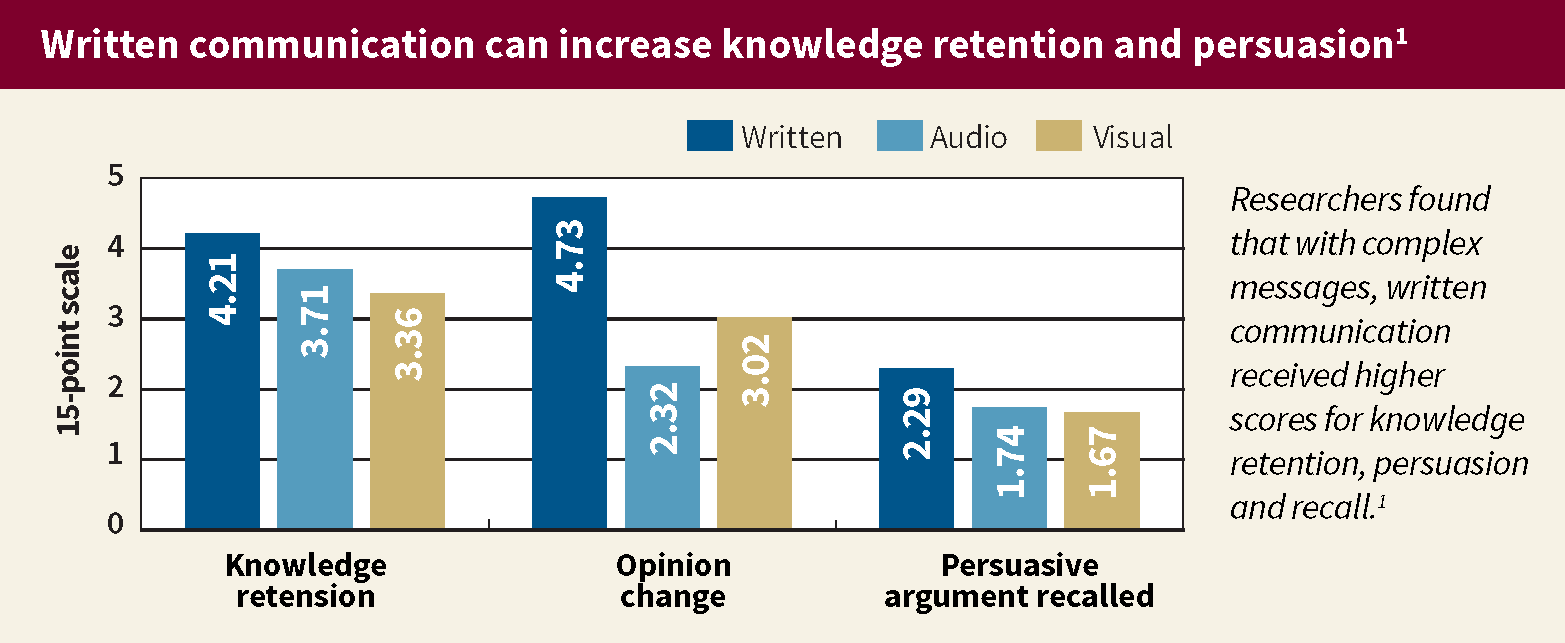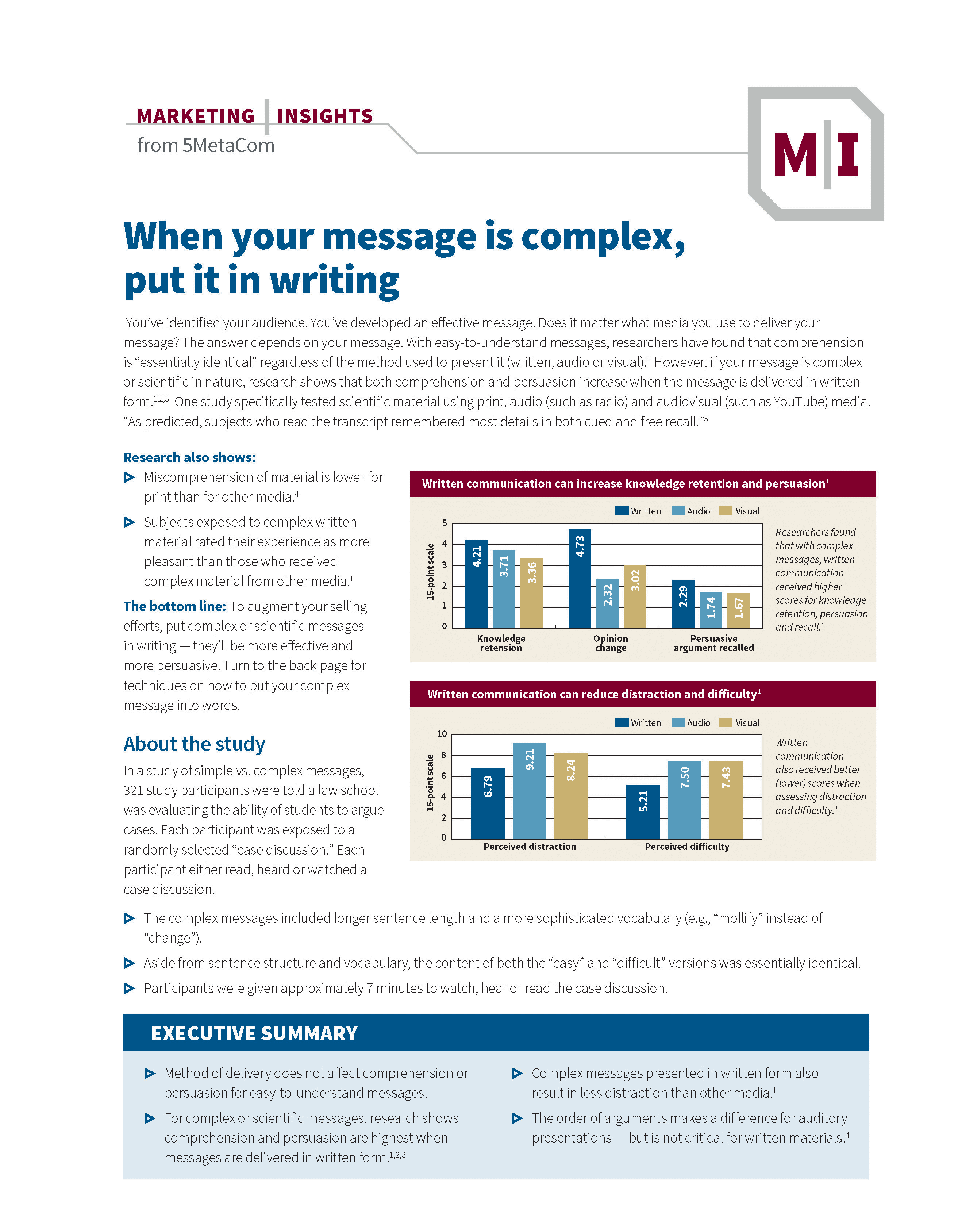When your message is complex, put it in writing
You’ve identified your audience. You’ve developed an effective message. Does it matter what media you use to deliver your message? The answer depends on your message. With easy-to-understand messages, researchers have found that comprehension is “essentially identical” regardless of the method used to present it (written, audio or visual).1 However, if your message is complex or scientific in nature, research shows that both comprehension and persuasion increase when the message is delivered in written form.1,2,3 One study specifically tested scientific material using print, audio (such as radio) and audiovisual (such as YouTube) media. “As predicted, subjects who read the transcript remembered most details in both cued and free recall.”3
Research also shows:
- Miscomprehension of material is lower for print than for other media.4
- Subjects exposed to complex written material rated their experience as more pleasant than those who received complex material from other media.1
The bottom line: To augment your selling efforts, put complex or scientific messages in writing — they’ll be more effective and more persuasive. Turn to the back page for techniques on how to put your complex message into words.


About the study
In a study of simple vs. complex messages, 321 study participants were told a law school was evaluating the ability of students to argue cases. Each participant was exposed to a randomly selected “case discussion.” Each participant either read, heard or watched a case discussion.
- The complex messages included longer sentence length and a more sophisticated vocabulary (e.g., “mollify” instead of “change”).
- Aside from sentence structure and vocabulary, the content of both the “easy” and “difficult” versions was essentially identical.
- Participants were given approximately 7 minutes to watch, hear or read the case discussion.
EXECUTIVE SUMMARY
- Method of delivery does not affect comprehension or persuasion for easy-to-understand messages.
- For complex or scientific messages, research shows comprehension and persuasion are highest when messages are delivered in written form.1,2,3
- Complex messages presented in written form also result in less distraction than other media.1
- The order of arguments makes a difference for auditory presentations — but is not critical for written materials.4
Copywriting techniques that create interest and understanding
Here are several guidelines that can help you develop effective copy when you have a complex message you want to deliver in writing.
- Lead your audience: Your audience follows a process as they go from awareness of your product to adoption of it (see graphic below). Think of an interstate highway — one your reader can turn off of at any point. Creating something for your audience to read (or look at) can solve awareness and lead them forward in the process.
- Create a spark of interest: Creating interest is perhaps the most important job of copy. The written material must bring meaning to complicated concepts. This can include many components — headlines, captions, charts, tables, etc. — that together should tell a story that makes complex ideas quickly and easily understood.
- Appeal to self-interest: Copywriting often boils down to helping your reader see what’s in it for them. A “me-first” appeal generally eclipses all others at creating interest and understanding.
- Think visually: Visuals and words can combine to create interest and understanding. Images (and words that elicit images) can function as mnemonic devices to help people remember you. Research shows material that readily conjures images may be remembered more effectively than abstract material.5
- Address fundamentals: Spelling mistakes or grammatical errors can erode your credibility. If your customer can’t trust you with something as simple as a comma, how can they trust you with complexities such as regulations, laws and processes?
Does the order of your arguments matter?
When you’re giving a presentation or writing a sales piece, should the most important argument come first or last? A study published in the Journal of Consumer Research concludes that when the media is predominantly auditory (such as radio or a live presentation), it’s advantageous to put the most favorable arguments first.4 For print messages, the study found no differences.
The customer’s path from awareness to adoption

A potential customer goes through several steps before becoming a loyal customer. Effective copywriting helps to address the first two steps (awareness & interest), leading the customer from one to the next.
1 Chaiken, S., & Eagly, A. Communication Modality as a Determinant of Message Persuasiveness and Message Comprehensibility. Journal of Personality and Social Psychology, 34(4), 605-614.
2 Corston, R., & Colman, A. (1997). Modality of Communication and Recall of Health-Related Information. Journal of Health Psychology, 2,185-194.
3 Furnham, A. Gunter, B., & Green, A. (1990). Remembering Science: the Recall of Factual Information as a Function of the Presentation Mode. Applied Cognitive Psychology, 4, 203-212.
4 Unnava, H., Burnkrant, R., & Erevelles, S. (1994). Effects of Presentation Order and Communication Modality on Recall and Attitude. Journal of Consumer Research, 21, 481-490.
5 Gunter, B., Furnham, A., & Gietson, G. (1984, Oct.-Dec.). Memory for the news as a function of the channel of communication. Journal of Practical Research and Application, 3(4), 265-271.
